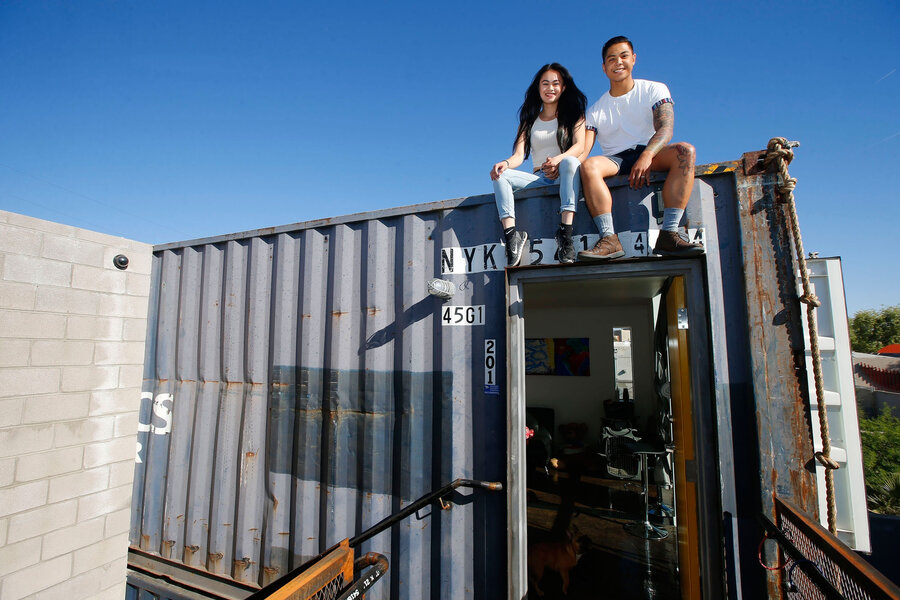Could shipping container homes offer a solution for urban housing crunch?
Loading...
Once thought of mostly as a utilitarian way to store cargo, developers across the country are increasingly embracing shipping containers for a new purpose – helping urban residents find affordable housing.
In Phoenix, a stack of shipping containers in an industrial lot has been transformed into eight apartments that embrace rather than hide their shipping past. Inside, however, the apartments made of two corrugated shipping containers have been reconfigured as modern homes with epoxied wood floors and white walls.
"It doesn't even feel like a shipping container. It's also insulated really well," Patrick Tupas, who is in the Air Force and signed a lease along with his wife told the Associated Press. "It just feels like a regular apartment."
A one-year lease is $1,000 a month, slightly above Phoenix’s average rent of $898 for a one-bedroom apartment, according to the rental site RentJungle.
For developers, the new "cargotecture," which has spread to neighborhoods in Las Vegas, Detroit, Washington, D.C., and as far as Denmark, offers both a way to cater to younger residents and baby boomers who want to live closer to the cultural attractions of urban areas and a cheaper, eco-friendly way to quickly build more housing. Some homes mask their industrial origins, while others include it in the homes' design.
"In Denmark, there's a lack of 20,000 student homes," Michael Plesner, cofounder and partner at CPH Containers, which is building a village of student homes in Copenhagen out of shipping containers, told TakePart.
"If scaled up, container villages can actually help push down the price on the general housing markets of cities, which would benefit everyone," he said.
About 1,000 unused shipping containers are available for purchase in the United States, where used models can sell for $1,000 and up, Barry Naef, director of the Intermodal Steel Building Units Association told TakePart.
For many middle-class residents hit hard by sky-rocketing rents in urban areas such as San Francisco, New York, Boston, and Seattle, the apartments could possibly represent an alternative option.
Middle-income residents are increasingly feeling the effects of a growing housing crunch, as the Monitor’s Jessica Mendoza reported in detail earlier this month:
Public-service workers, police, teachers, ... and other middle-income residents – lacking the welfare support and housing assistance of the very poor – are being hit particularly hard. They are increasingly being forced to make a fundamental choice: keep the jobs they have and settle for interminable commutes and smaller living spaces, or relocate to more affordable cities altogether.
Because the homes can combine multiple shipping containers together, that may provide more flexible options for people who are skeptical of the growing "tiny home" craze, where the average home ranges from 100 to 400 square feet.
Washington's Brookland neighborhood has had a four-story housing cluster made of shipping containers since September 2014, while containers in Las Vegas are featured in a downtown retail complex.
A company called Three Squared Construction has spent $14 million on new projects that involve shipping containers in Detroit. The company opened the city's first-resident development made of repurposed containers in April 2015. It's currently used as a showcase, while the top floor is periodically rented out.
In Phoenix, all but two of the eight units are occupied; one is pitched as a vacation rental. Architecture firm StarkJames has plans to build 12 more container houses in downtown Phoenix. These homes will be stacked three stories high. But other developers have been skeptical.
“We work with a lot of other developers," architect Brian Stark told the AP. "They always ask 'How are the garbage can homes going?'"
But the company is undeterred. It's taking the jokes in stride, naming its downtown developer The Oscar, after the "Sesame Street" character Oscar the Grouch, who could be considered a container-dwelling pioneer.
This report contains material from the Associated Press.







